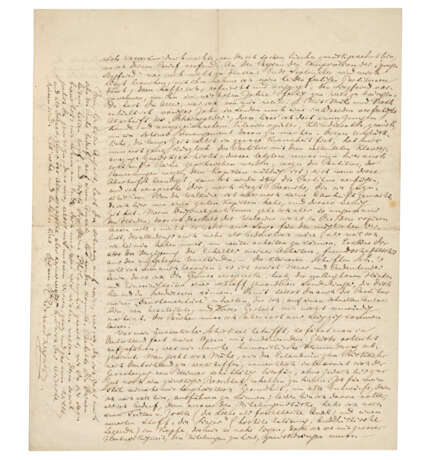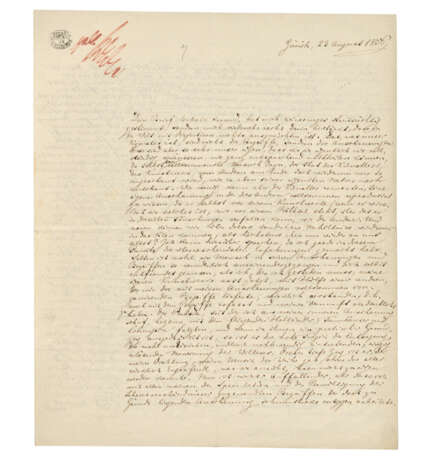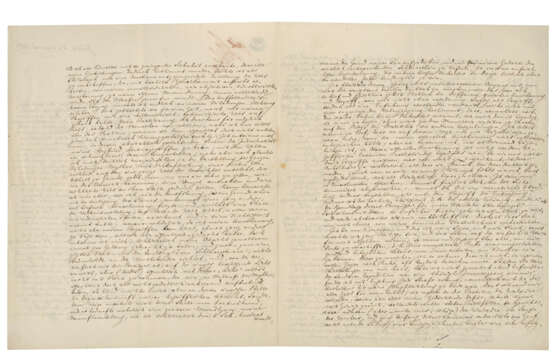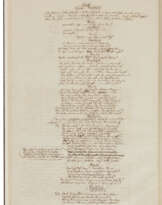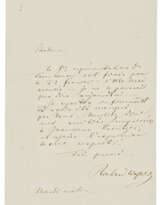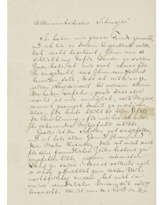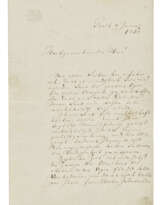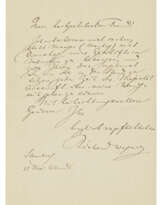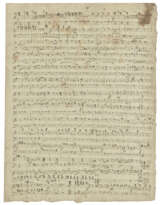ID 1109064
Lot 264 | Richard Wagner (1813-1883)
Estimate value
£ 5 000 – 8 000
Autograph letter signed ('Richard Wagner') to [August Röckel], Zurich, 23 August 1856
In German. Four pages, 270 x 226mm, ink stamp of Waldheim prison and red ink marking at upper left of p.1, presumably of prison censor. Provenance: Calvin Bullock (1867-1944), and by descent – Christie's New York, 14 May 1985, lot 103.
On the opposition between conceptions and intuitions underlying Wagner's entire creative process. Röckel's letter has confirmed Wagner in his conviction that 'nothing in this world is gained by discussion. That in us, which is essentially and fundamentally our own, is not our conceptions (Begriff) but our intuitions (Anschauung)', but these intuitions can never be fully communicated, or adequately comprehended by others. Wagner's own experience in the presence of his work is that of being 'confronted by a riddle', and he expresses his sense of a 'profound division and estrangement' between the intuitive and conscious parts of his nature. His period of working in obedience to his intuitions is that of The Flying Dutchman, Tannhäuser and Lohengrin: 'if there is any expression of an underlying poetic motive in these works, it is to be sought in the sublime tragedy of renunciation, the negation of the will'. The curious thing is that his 'intellectual ideas' have always worked in direct opposition to the 'intuitive ideas' as expressed in these works. The most remarkable expression of this is in the creation of the Ring cycle: his intention in conceiving the personality of Siegfried was that of 'representing an existence free from pain. But I meant in the presentment of the whole Nibelung myth to express my meaning even more clearly, by showing how from the first wrong-doing a whole world of evil arose'; and yet in the actual elaboration of the work, something quite different was expressed, whereby 'instead of conceiving a phase in the development of the world, I had grasped the very essence and meaning of the world itself in all its possible phases, and had realized its nothingness'. Only in Brünnhilde's final invocation of live was he 'led astray' from this intuition. It is only now, through his study of Schopenhauer, that he has resolved this spiritual crisis. The letter concludes with more mundane news: Wagner's expedition to London was a mistake, and left him ill and almost incapable of working on Die Walküre. Liszt is to visit soon, and Wagner will go through the scores completed so far with him, before embarking on Siegfried. He has had a piano arrangement made of Rhinegold, and once this is available he will send the score to Röckel: he is deeply anxious about letting the original scores out of his sight, even for copying. As for external events, his works are being performed widely, but badly, and there are moves underway that might permit his return to Germany; he hopes only for health, to complete the Ring, and to realise other projects, including Tristan und Isolde (quotations in the translation by Eleanor C. Sellar).
August Röckel (1814-1876) formed a close friendship with Wagner whilst working under him as assistant conductor at the Dresden Court Theatre from 1843-1848. He was closely involved in the 1849 Dresden uprising, as a result of which he was sentenced to 13 years imprisonment at the Königstein Fortress and Waldheim, during which period he engaged in a celebrated correspondence with Wagner.
| Artist: | Richard Wagner (1813 - 1883) |
|---|---|
| Place of origin: | Germany |
| Artist: | Richard Wagner (1813 - 1883) |
|---|---|
| Place of origin: | Germany |
| Address of auction |
CHRISTIE'S 8 King Street, St. James's SW1Y 6QT London United Kingdom | |||||
|---|---|---|---|---|---|---|
| Preview |
| |||||
| Phone | +44 (0)20 7839 9060 | |||||
| Buyer Premium | see on Website | |||||
| Conditions of purchase | Conditions of purchase |
